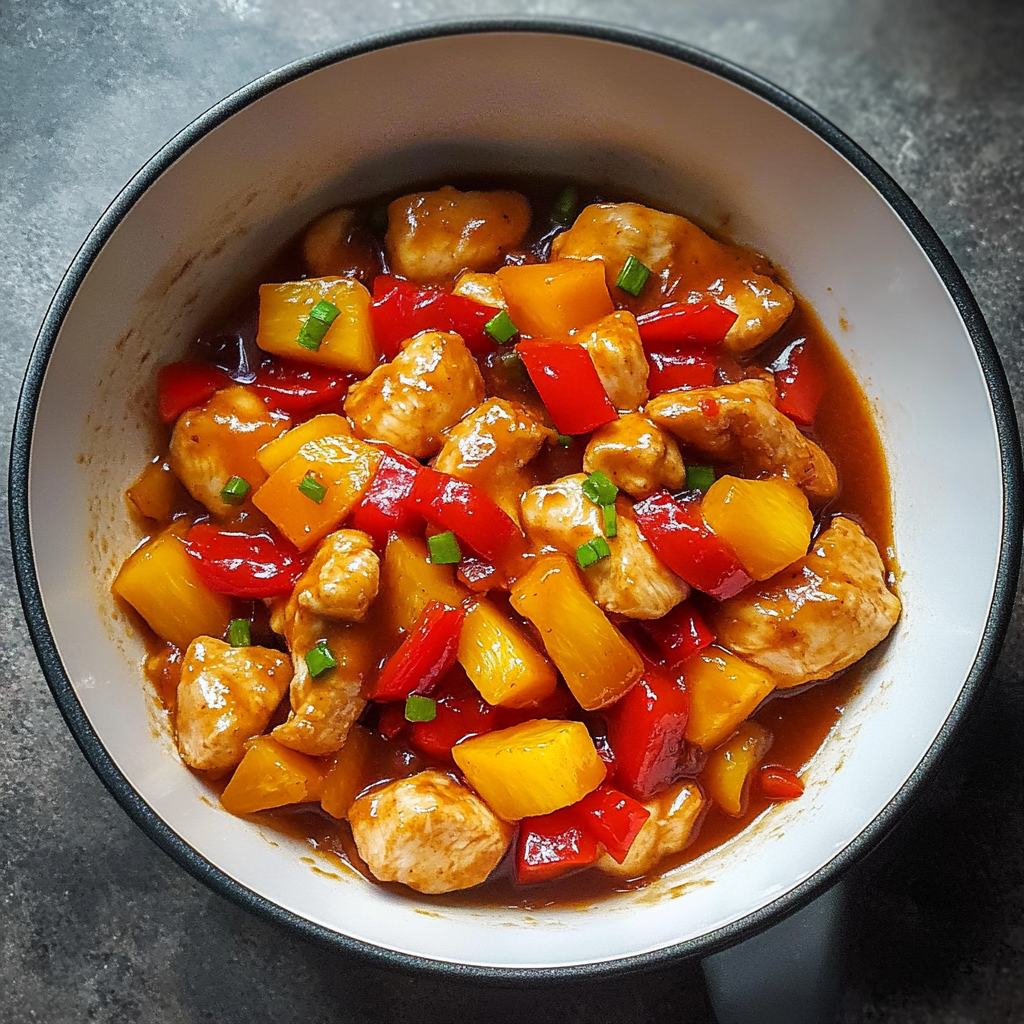This Sweet and Sour Chicken recipe brings the perfect balance of crispy chicken pieces and a tangy, sweet sauce. The addition of vibrant bell peppers and juicy pineapple chunks adds a delightful crunch and burst of flavor. It’s a dish that’s sure to please the whole family, offering a healthier alternative to takeout without compromising on taste.
Enjoy this quick and easy recipe for a satisfying meal any night of the week.
Full Recipe
Ingredients:
-
500g boneless, skinless chicken breast, cut into bite-sized pieces
-
1/2 cup cornstarch
-
Salt and pepper, to taste
-
2 tablespoons vegetable oil
-
1 medium onion, sliced
-
1 red bell pepper, chopped
-
1 yellow bell pepper, chopped
-
1/2 cup pineapple chunks (fresh or canned)
-
1/4 cup ketchup
-
2 tablespoons apple cider vinegar
-
2 tablespoons brown sugar
-
2 tablespoons soy sauce
-
1 teaspoon fresh ginger, grated
-
2 cloves garlic, minced
Directions:
-
Coat the Chicken: In a medium bowl, season cornstarch with salt and pepper. Toss chicken pieces in the cornstarch mixture until evenly coated.
-
Fry the Chicken: Heat vegetable oil in a high-sided skillet over medium heat. Fry the cornstarch-coated chicken pieces until golden brown on all sides. Remove and set aside on a paper towel-lined plate.
-
Sauté the Onion: In the same skillet, add sliced onion and sauté until softened, scraping up any browned bits from the bottom of the pan.
-
Add Bell Peppers: Add chopped red and yellow bell peppers to the skillet and stir-fry until they begin to soften.
-
Prepare the Sauce: In a bowl, whisk together ketchup, apple cider vinegar, brown sugar, soy sauce, grated ginger, and minced garlic until smooth.
-
Combine and Cook: Pour the sauce mixture into the skillet with the vegetables. Add pineapple chunks and bring to a simmer. Let the sauce thicken slightly.
-
Add Chicken: Return the fried chicken pieces to the skillet, stirring to coat them in the sauce. Cook for an additional 5-6 minutes, or until the chicken is cooked through.
-
Serve: Serve the sweet and sour chicken over steamed rice or noodles, garnished with green onions if desired.
Prep Time: 15 minutes | Cooking Time: 15 minutes | Total Time: 30 minutes
Kcal: 350 kcal | Servings: 4 servings
The Origins of Sweet and Sour Chicken
Sweet and sour chicken is a beloved dish that traces its roots to Chinese cuisine, particularly Cantonese cooking. Traditionally, the sweet and sour flavor combination has been used in China for centuries, with early iterations involving pork, vegetables, and fruits in vinegar-based sauces. When Chinese immigrants brought their culinary traditions to Western countries, the dish evolved to accommodate local tastes, especially in the United States and the United Kingdom. Over time, chicken became a popular protein of choice, and the sauce was modified to include ingredients like ketchup and sugar to appeal to a wider audience. The result is the iconic dish we know today—a perfect marriage of crispy fried chicken coated in a glossy, tangy, and sweet sauce.
Why This Dish Has Global Appeal
There’s a reason sweet and sour chicken is a staple on Chinese restaurant menus across the globe. The flavor profile—tangy, sweet, savory, and slightly acidic—is universally appealing. The contrast between crispy fried chicken and the rich sauce makes it irresistible to people of all ages. Beyond its taste, the dish is colorful and visually enticing. The use of red and yellow bell peppers, along with pineapple chunks, brings a vibrancy that’s as delightful on the plate as it is on the palate.
Sweet and sour chicken also fits comfortably into the category of “fakeaway” meals, where home cooks attempt to recreate takeout favorites with fresh, wholesome ingredients in the comfort of their own kitchens. This versatility and familiarity contribute significantly to its ongoing popularity.
Customizing Your Sweet and Sour Chicken
One of the strengths of sweet and sour chicken is how adaptable it is. While the traditional version uses battered and fried chicken breast, you can switch to chicken thighs for a juicier bite or even tofu or cauliflower for a vegetarian or vegan alternative. You can also adjust the sauce to suit your dietary needs or flavor preferences. Want it tangier? Add more vinegar. Looking for a less sweet version? Cut down on the sugar or use natural sweeteners like honey or maple syrup.
Vegetables like carrots, snap peas, or broccoli can be added for extra nutrition, and using fresh pineapple instead of canned can give the dish a brighter, more tropical flavor. Additionally, you can tweak the spice level by including chili flakes or a dash of sriracha if you prefer a bit of heat.
Tips for Perfect Results Every Time
If you want restaurant-quality sweet and sour chicken at home, here are a few essential tips:
-
Don’t skip the cornstarch coating: It helps create that irresistible crispy texture when frying the chicken.
-
Use high heat when frying: This ensures that the chicken sears quickly, locking in moisture without becoming greasy.
-
Cook your sauce separately: Letting the sauce simmer and thicken before combining it with the chicken helps maintain crispness and avoids soggy results.
-
Add veggies at the right time: Overcooking bell peppers and onions can make them mushy. Add them in just long enough to soften slightly but retain their bite and color.
Serving Suggestions and Pairings
Sweet and sour chicken pairs beautifully with a variety of side dishes. Steamed jasmine or basmati rice is a classic choice that absorbs the sauce well and balances the strong flavors. Fried rice, with egg and green onions, is another popular option that makes the meal feel more indulgent and satisfying.
For a lower-carb alternative, you can serve the dish over cauliflower rice or alongside stir-fried greens like bok choy or spinach. If you’re preparing a full meal for guests, consider serving it with spring rolls, dumplings, or a light Asian-inspired salad for a complete dining experience.
To complement the flavors, pair sweet and sour chicken with light white wines such as Riesling or Pinot Grigio. These wines have a touch of sweetness and acidity that matches well with the tangy sauce. For a non-alcoholic option, iced green tea or sparkling water with lime works wonderfully.
Making it Ahead and Storing Leftovers
This recipe is ideal for meal prepping and can be stored for later use. The sauce can be made in advance and refrigerated for up to 3 days. Simply reheat it gently before adding to freshly cooked chicken.
If you’re making the entire dish ahead of time, store the chicken and sauce separately when possible. This prevents the chicken from becoming soggy. Reheat the chicken in an oven or air fryer to restore some of the crispiness, and warm the sauce on the stovetop before combining them just before serving.
Leftovers can be kept in the refrigerator for up to 3 days and also freeze well for up to a month. For best results, thaw frozen portions overnight in the fridge before reheating.
Healthier Variations of Sweet and Sour Chicken
While the traditional version involves deep-frying, you can lighten up the dish without compromising on flavor. Here are a few healthier alternatives:
-
Air fryer method: Instead of deep-frying, cook the chicken in an air fryer for a crispy texture with minimal oil.
-
Oven-baked option: Coat the chicken in cornstarch and bake in a hot oven until golden and crisp.
-
Stir-fry style: Skip the batter altogether and stir-fry the chicken pieces in a small amount of oil for a lighter version.
-
Low-sugar sauce: Replace brown sugar with coconut sugar or reduce the quantity to limit added sugars. You can also experiment with using fruit juice for natural sweetness.
These variations make sweet and sour chicken more suitable for those following specific diets, including gluten-free (with tamari instead of soy sauce), low-carb, or low-fat eating plans.
Cultural Influence and Modern-Day Relevance
Sweet and sour chicken stands at the crossroads of traditional Chinese flavors and Western food culture. Its development reflects how food evolves when cultures blend. What began as a simple vinegar-based sauce has turned into a beloved household name worldwide, thanks to its adaptability and flavor harmony.
In modern-day cooking, it serves not just as a comfort meal but also as an example of how food can be both nostalgic and innovative. Home cooks and chefs alike continue to reinvent the dish by introducing unique twists—from adding exotic fruits to using international sauces like tamarind or pomegranate molasses.
Food trends also play a role in its continued relevance. As global interest in homemade versions of takeout favorites rises, sweet and sour chicken remains a top contender for people wanting easy, impressive, and delicious recipes that don’t sacrifice taste for convenience.
Conclusion
Sweet and sour chicken is more than just a dish—it’s a story of culinary fusion, global influence, and timeless appeal. Its vibrant colors, balanced flavors, and comforting textures make it a favorite for weeknight dinners, family gatherings, and even special occasions. The beauty of this dish lies in its simplicity and the endless ways it can be customized to fit different lifestyles and tastes.
Whether you’re a home cook exploring Asian-inspired cuisine for the first time or a seasoned food lover seeking a new twist on a classic, sweet and sour chicken delivers a satisfying and flavorful experience every time. It embodies what good food should be: easy to make, joyful to share, and unforgettable to taste.






